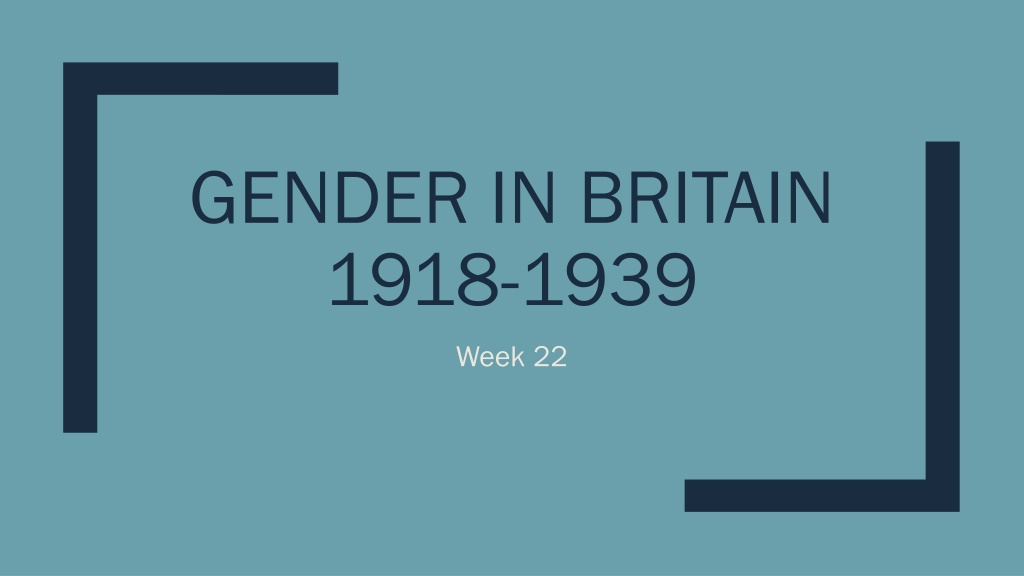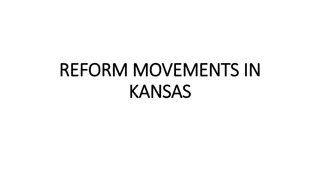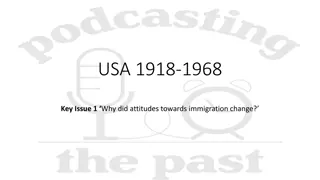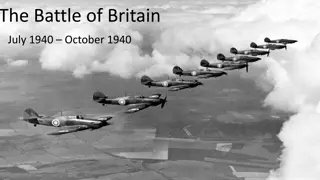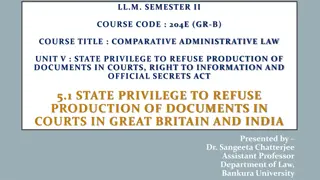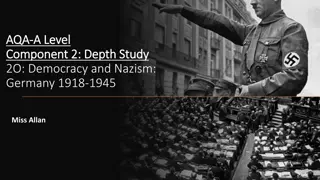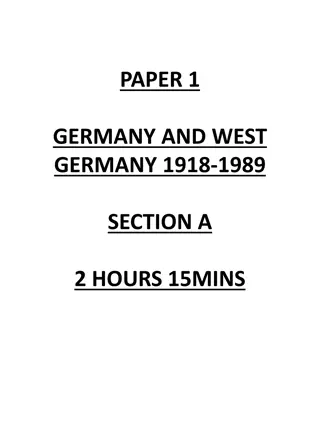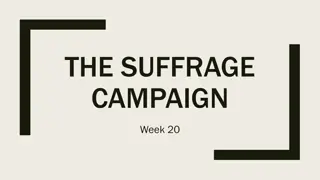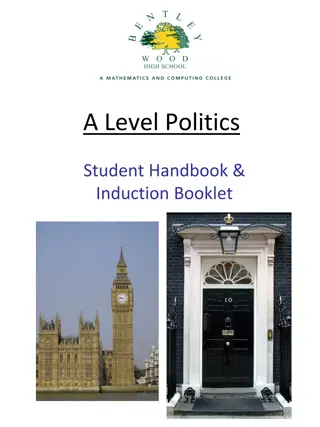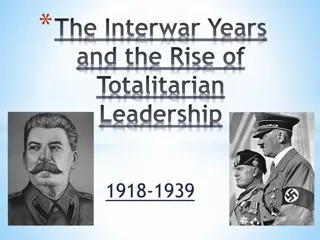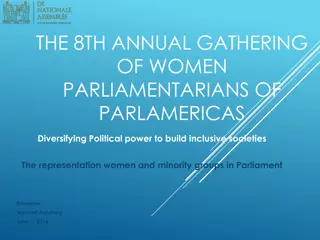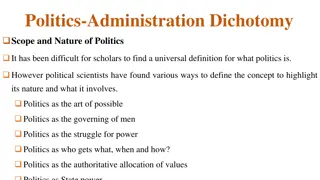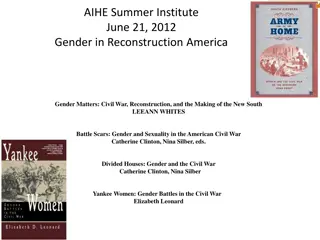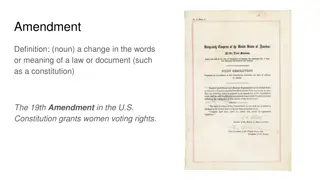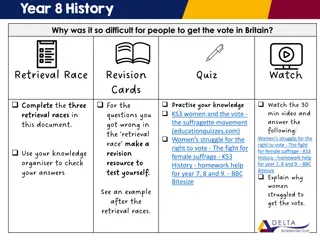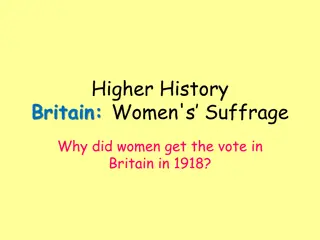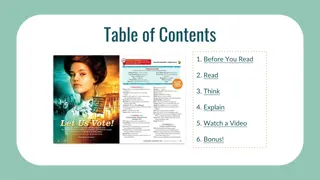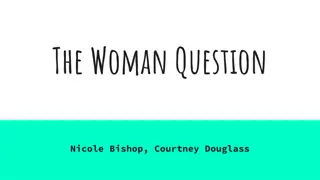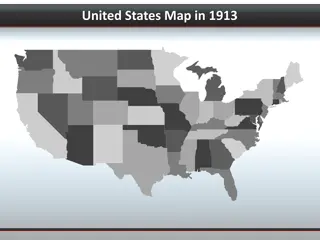The Impact of Female Suffrage on Interwar Politics in Britain (1918-1939)
The period between 1918 and 1939 in Britain saw significant changes in politics, feminism, and society due to the granting of female suffrage. The Representation of the People Act of 1918 led to a flurry of legislation aimed at improving the status and welfare of women, such as the Sex Disqualification Removal Act and the Maternity and Child Welfare Act. Women started influencing interwar politics through local government participation and the election of women MPs, like Nancy Astor. The feminist movement of the interwar period, spearheaded by figures like Millicent Fawcett, aimed at achieving equal rights and opportunities for women in society.
Download Presentation

Please find below an Image/Link to download the presentation.
The content on the website is provided AS IS for your information and personal use only. It may not be sold, licensed, or shared on other websites without obtaining consent from the author. Download presentation by click this link. If you encounter any issues during the download, it is possible that the publisher has removed the file from their server.
E N D
Presentation Transcript
GENDER IN BRITAIN 1918-1939 Week 22
Overview: Politics. Feminism. Society Conclusions.
Impact of female suffrage on interwar politics: 1918 Representation of the People Act - immediate impact on politics. Sudden flurry of legislation concerned with status and welfare of women. Sex Disqualification Removal Act, 1919 Sex Disqualification Removal Act, 1919 enabled entry to certain professions. In 1918, child maintenance for illegitimate children increased from five to ten shillings a week. The Midwives Amending Act, The Midwives Amending Act, the Nurses Registration Act, Maternity and Child Welfare Act, Maternity and Child Welfare Act, improved health and welfare facilities for mothers and children. The Industrial Courts Act, 1919 Industrial Courts Act, 1919, appointed women to newly established courts of arbitration on pay and working conditions. Nurses Registration Act, and the
Millicent Fawcett We did not, except as a symbol of free citizenship, value [the vote] as a thing good in itself . . . but for the sake of equal laws, the enlarged opportunities, the improved status of women which we knew it involved. We worked for it . . . because . . . it would benefit not women only, but the whole community . . . it was the cause of men, women and children cause of men, women and children. it was the
Womens influence on interwar politics. Local government: In 1937 sixteen percent of London borough councillors were female and women made up five per cent of the membership of other councils. 1918 Commentators expressed unease and uncertainty about women's voting preferences and perceived women as politically powerful despite their small numbers in parliament The press treated women voters as a single bloc whilst male voters were differentiated by class, occupation. Yet, of those women granted the vote in 1918 the majority voted Conservative. 1928 Lord Rothermere (owner of Daily Mail) convinced that young in 1928 would vote socialist. Labour did increase its poll in 1929 election by 3 million and Conservatives by only 600,00. No great shake up of political system. young women enfranchised
Womens influence on interwar politics politics The Parliament Qualification of Women Act (1918): allowed women to become MPs. 1stwoman elected was Constance Constance Markievicz Markievicz in 1918. Yet, as a member of Sinn Fein, she did not take her seat. 1stwomen to take her seat was Nancy Astor in 1919. Conservative MP for the Plymouth Sutton following husband, Waldorf Astor s appointment to peerage. Retained seat until she stood down in 1945. Not a Suffragette! Yet, advocate for women s issues while husband fought for female entry to House of Lords.
Meanwhile, interwar feminism ... 1919: Millicent Garret Fawcett resigned as leader of NUWSS (AKA National Union of Societies for Equal Citizenship) as focused on broad agenda not just franchise. Replaced by Eleanor Rathbone. Rathbone did not promote gender equality but an equal valuation of different gender roles. Her major campaign was for sizable family allowances paid to mothers. Her campaigns lost popularity and the women s movement fragmented in the interwar period. The 478 original branches were reduced to 90 by 1929 and 48 by 1935.
Vera Brittain (1893-1970) Feminist and passivist Experienced tragedy in WWI when working as a nurse dead brother, friend and fianc . Testament of Youth autobiography Edwardian middle class family and domestic ideology. WWI bereavement, futility of war and nursing Student at Oxford- ambition to be writer. Post war marriage and activism.
Brittain and Feminism Brittain met Winnifred Holtby at University, lived together later in life. Associated with active feminists working in London Brittain and Holtby began to work for the Six Point Group est 1921. Six goals: widow s pension, equal parental rights, tighter laws on child assault and unmarried mothers, equal pay for teachers and equal opportunities in the Civil Service. Middle class goals career focused goals. Holtby became a director of feminist journal Time and Tide in 1926 and Brittain was a regular contributor.
Interwar feminism Traditionally overlooked by historians (Caine: Feminism and the woman citizen in the interwar years ). Neglect due to: Eclipsed by pre-war suffragette movement. Notion campaigning stopped with vote - goal achieved. Tame ideas- no threat to social structure- focus on motherhood and welfare. Tame activities- lobbying MPs, meeting, specialist publications- contrast to militancy. Divisions in feminist movement- lack of unity a cause for weakness? (e.g. Brittain v Rathbone)
Interwar feminism Historians more recently have been celebrating the diversity of the interwar feminist groups rather than emphasising failure . At least 23 pieces of legislation were passed between 1918 and 1930 for which women's groups lobbied because they believed that they would promote gender equality. There were new welfare measures, such as the first state pensions for widowed mothers and orphans (1925).
Society: Employment Middle class women better educated. YET, marriage bar enforced. 1930: 1 in 10 married women worked (most working class). Great Depression/General Strike Young women contributing to household income. Working classes still in domestic service 70% working women were servants. By 1931 10% 10% of young women workers were shop assistants, and 12.5% clerks. Employment patterns differed by locality. In Northumberland, (mining) just 43% of girls girls were in work in 1931, compared with 78% of boys In Blackburn (mill town) 79% of both girls and boys 79% of both girls and boys were in the labour force in 1931. 12.5% were 43% of 78% of boys.
Society: Sexuality Despite New Woman and Flapper, traditional moral ideals prevailed. The Eugenics Society est, 1907 viewed women as guardians of future British race . Disliked working women. The Mental Deficiency Act of 1913 gave local authorities powers over pregnant women who were homeless, destitute or immoral . There was an attempt in 1921 to criminalise lesbianism. The Obscene Publications legislation was used to repress Radclyffe Hall s The Well of Loneliness written in 1928 Marie Stopes founded a birth control clinic but contraception was controversial and its availability largely confined to middle and upper class women. Abortion remained illegal although in 1929 abortion permitted if the mother s life was in danger.
Conclusions Period overlooked by militancy of Suffragettes and influence of 2ndwave feminists in 1960s. Feminism overshadowed by global and economic events. Class divided feminists on new goals: elevate mothers or break professional class ceilings. Despite a change in women's role in politics progress in society limited.
